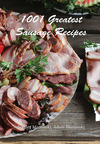Meats and Sausages
Canning Vegetables
Vegetables are low-acid foods and are subject to the same regulations as meat, poultry and fish. As vegetables grow in soil they usually contain large numbers of microorganisms. As explained earlier, the soil is the major carrier of Cl.botulinum spores. Vegetables are always washed but that removes only a part of the microorganisms and soil. The next step, known as blanching removes, kills or inactivates the majority of microorganisms present in vegetables. However, the ones that pose the highest security risk; Cl.botulinum survive as bacterial spores. Vegetables are low-acid food and as such will not prevent Cl. botulinum spores from germinating and producing toxin so they must be dealt with similarly to meats. Vegetables must be submitted to 240-250° F, 116-121° C heat treatment like all other low-acid foods in order to kill Cl.botulinum spores. High temperature thermal process often adversely affects delicate textured food like vegetables so commercial producers acidify the product to below pH 4.6. That allows them to process vegetables at pasteurization temperature. Look at the products in a supermarket; most food, for example, different types of pickles are acidified with vinegar in order to process them at lower temperature. For example, pH of cucumbers varies from 5.1-5.7, but pH of canned dill pickles is 3.2-3.5. Low-acid products acidified recipes are designed by the processing authority and approved by the FDA. However, the United Stated Department of Agriculture Bulletin 539 list many vegetable recipes that may be safely canned at home. All information in this book applies to both, vegetables and meat products and that includes equipment, processing steps and testing methods. The table below lists some common fruits and vegetables according to their pH. Acidity of foods depends upon many factors such as variety, maturity and growing conditions of the product. For these reasons, the pH of food is usually within a range of values.
| Vegetables | pH |
|---|---|
| Artichokes | 5.6 |
| Asparagus | 4-6 |
| Beans | 5.7-6.2 |
| Brussel sprouts | 6.0-6.3 |
| Cabbage | 5.2-6.0 |
| Carrots | 4.9-5.2 |
| Cauliflower | 5.6 |
| Celery | 5.7-6.0 |
| Chives | 5.2-6.1 |
| Corn | 6.0-7.5 |
| Cucumbers | 5.1-5.7 |
| Eggplant | 4.5-5.3 |
| Horseradish | 5.35 |
| Kale, cooked | 6.4-6.8 |
| Leeks | 5.5-6.0 |
| Lettuce | 5.8-6.0 |
| Lentils, cooked | 6.3-6.8 |
| Mushrooms, cooked | 6.2 |
| Okra, cooked | 5.5-6.4 |
| Olives, green | 3.6-3.8 |
| Olives, ripe | 6.0-6.5 |
| Onions | 5.3-5.8 |
| Parsley | 5.7-6.0 |
| Parsnip | 5.3 |
| Peas | 5.8-7.0 |
| Pepper | 5.15 |
| Pimiento | 4.6-4.9 |
| Potatoes | 6.1 |
| Pumpkin | 4.8-5.2 |
| Radishes, red | 5.8-6.5 |
| Radishes, white | 5.5-5.7 |
| Rhubarb | 3.1-3.4 |
| Rice, cooked | 6.0-6.7 |
| Sauerkraut | 3.4-3.6 |
| Spinach | 5.5-7.2 |
| Tomatoes, whole | 4.2-4.9 |
| Turnips | 5.2-5.5 |
| Zucchini, cooked | 5.8-6.1 |
| Fruits | pH |
|---|---|
| Apples | 3.3-3.9 |
| Apricots | 3.3-4.0 |
| Bananas | 4.5-5.2 |
| Cantaloupe | 6.17-7.13 |
| Dates | 6.3-6.6 |
| Figs | 4.6 |
| Grapefruit | 3.0-3.3 |
| Lemons | 2.2-2.4 |
| Mangos | 3.9-4.6 |
| Melons | 5.5-6.7 |
| Nectarines | 3.9 |
| Oranges | 3.1-4.3 |
| Papaya | 5.2-5.7 |
| Peaches | 3.4-3.6 |
| Persimmons | 5.4-5.8 |
| Pineapple | 3.3-5.2 |
| Plums | 2.8-4.6 |
| Prunes | 3.1-5.4 |
| Tangerines | 4.0 |
| Watermelon | 5.2-5.8 |
| Berries | pH |
|---|---|
| Blackberries | 3.2-4.5 |
| Blueberries | 3.7 |
| Cherries | 3.2-4.1 |
| Cranberries | 2.4 |
| Currants, red | 2.9 |
| Gooseberries | 2.8-3.1 |
| Grapes | 3.4-4.5 |
| Raspberries | 3.2-3.7 |
| Strawberries | 3.0-3.5 |
Vegetables must be cleaned by soaking in water, spray washing or both. Then they are peeled, trimmed, and the large ones are reduced in size to make them suitable for packing. Next comes blanching. Blanching is a cooking process wherein the food substance, usually a vegetable or fruit, is plunged into hot water (close but below boiling point) for a few minutes only and plunged into iced water or placed under cold running water to stop the cooking process. Blanching liberates air and other gases which are present in cells of fruits and vegetables. If they are not removed prior to sealing, the air trapped in vegetables will be released into the headspace and will affect heat transfer, cause product oxidation and even internal corrosion of the containers. Blanching reduces the amounts of microorganisms and pesticides, improves the washing process and softens the skin for peeling. It also de-activates some of the enzymes that might affect the flavor, color and texture of the product.
















